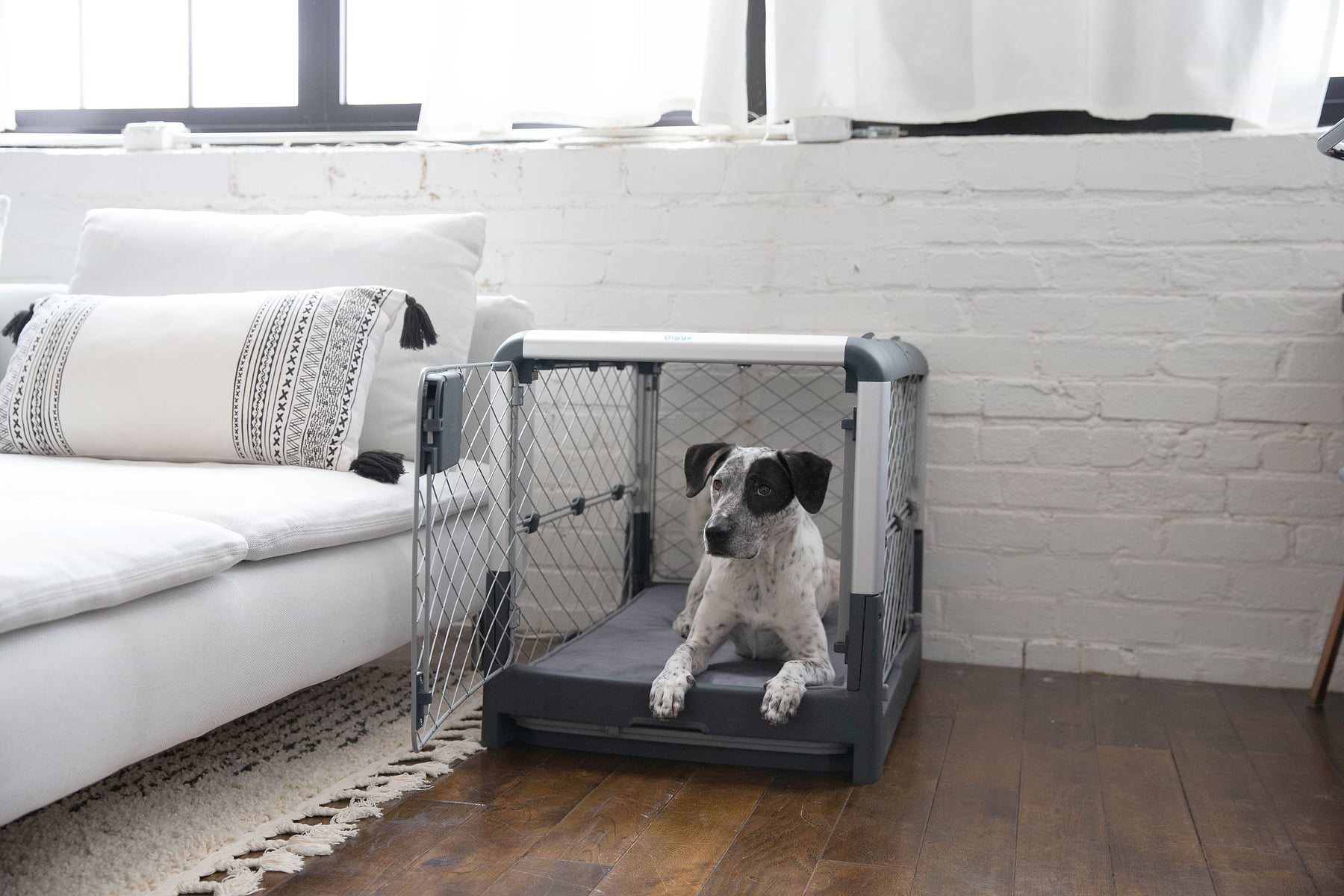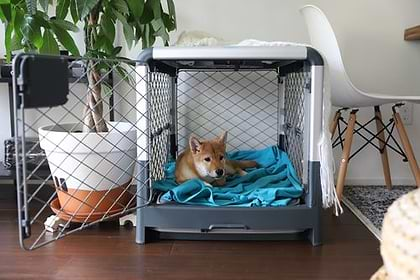Your dog's crate will ideally become their home within a home: a place of rest and relaxation where they sleep at the end of each day and where they can enjoy some alone time if needed. But lots of pet parents struggle with acclimating their new puppies to their crates. Even adult dogs may not be super comfortable in crates if they don't have everything they need.
That’s why it’s important to know what to put in dog crates to ensure maximum comfort and safety. No two crates are alike, and no two dogs require the exact same number or type of accessories. With that in mind, let’s break down some of the most important dog crate accessories, including beds, water bowls, and more.
By the end, you’ll know exactly what your puppy needs in their crate to feel comfortable and secure.
Dog Bedding
Naturally, one of the main things you’ll want to include in your dog’s crate is good bedding. If you want your dog to view their crate as a secure, comfortable place where they can relax at the end of the day and where they can retreat if they are overstimulated, they need to be comfy when they lie down.
Naturally, one of the main things you'll want to include in your dog's crate is good bedding. If you want your dog to view their crate as a secure, comfortable place where they can relax at the end of the day and where they can retreat if they are overstimulated, they need to be comfy when they lie down. A simple towel or pillow just won't do the trick. Dogs need something plush, squishable, and overall comforting. That's why we created a range of dog bedding options to suit every pup's needs: Snooz, Pillo, and Bolstr.
What’s the Ideal Dog Bedding?
The ideal dog bedding will be:
- Perfectly sized to fit the interior of your dog's crate. If it's a little too large or a little too small, your dog might not find it as comfortable as you hope. Plus, it may mean that they end up having to sleep on the floor of their crate instead of a comfy bed
- Made of high-quality materials that are designed to last while also being comfortable for your pup.
- Easy to clean, since even adult dogs can occasionally have messes! That’s okay so long as your dog’s bed can be thrown in the wash or cleaned by hand without too much trouble
So, what should you put in your dog's crate? Lots of new pet owners toss a bunch of pillows inside a dog crate or try to pile up several blankets inside. But this approach has a couple of major problems.
Snooz is a specially designed orthopedic dog crate pad. It's orthopedic since it helps your dog feel comfortable throughout their sleep and may aid in preventing them from experiencing certain muscle-related issues or joint pain.
Snooz is made of memory foam without any ozone-depleting materials, flame retardants, or formaldehyde. It features an easy-to-remove cover that can be washed if your puppy makes a mess while they are still being crate trained. It's designed for Diggs' Revol crate, but it can also be used outside of the crate.
Pillo is a rugged bed that allows for customizable firmness, designed for natural dog behaviors. Its adjustable filling allows you to customize the comfort level for your pup's preference. Pillo is resistant to bites, chews, and scratches, making it perfect for teething puppies or dogs who love to dig. It functions as a standalone or crate bed with a washable waterproof lining.
Bolstr is a versatile bed with a bolstered headrest, fitting both Diggs Evolv and standard wire crates. The durable fabrics with a water-repellent cover make it easy to clean and maintain. The bolstered design supports your dog's head and neck for improved rest, while the CertiPUR-US® foam ensures ultimate comfort.
Ultimately, Snooz, Pillo, and Bolstr are perfect choices to put in your Revol, Evolv, or any other dog crate, provided you choose the pad size that's perfect for your pup's needs. You can even pick up a couple of different beds if you like. This way, your dog could have a bed in the living room and one in their crate and recognize the beds as "theirs" since they'll both be made of high-quality materials designed for their comfort.
Should You Leave Clothing in Your Dog’s Crate?
Some new pet owners might think it’s wise to leave clothes that smell like them within their dogs’ crates. But this might not always be a good idea for the same reasons mentioned above regarding blankets.
Simply put, your dog might decide to chew and tear up any shirts or other clothing you put in your dog’s crate, even if they smell like you. This isn’t a warning sign, of course; it just means your pup might be a little bored and has decided to entertain themselves.
Unfortunately, lots of modern clothes are made with synthetic fibers and other materials that can wreak havoc on your dog’s digestive system if they swallow those fibers. Additionally, fabric and strings can potentially cause blockages or other damage to your dog's intestines. Because of this, you shouldn’t put any clothing in your dog’s crate.
What if your dog doesn't usually chew on anything? In that case, you have a very well-behaved pup! But even so, it's probably wiser and safer to avoid leaving clothing in your dog's crate.
There may be one exception to this if it’s recommended by a professional dog trainer: when you are trying to train your dog out of separation anxiety. In this case, clothing that smells like you could calm your dog and help reassure them that you aren’t actually far away if you have to leave them in their crate for some time.
Once again, leaving clothing out of your dog’s crate is the best idea for most folks and pets.
Food and Water Bowls
Aside from bedding, you may also wish to leave food and/or water bowls in your dog’s crate. There are a few different schools of thought and approaches to these inclusions, so let’s break down both topics in more detail.
Leaving Food in Your Dog’s Crate
Food is the road to your dog’s heart (and, let’s be honest, the hearts of many humans!). Therefore, there’s a certain amount of wisdom to offering some food to your dog when they are in their crate, especially when you are crate training them for the first time.
But what if they’ve already been crate trained? Should you leave food in their crate afterward?
Generally speaking, no. Free feeding your dog isn’t usually wise as most dogs are not able to moderate their food intake such that they won’t become overweight or overfed if allowed. However, you can feed your dog in their crate, especially when they are young.
This helps your dog form positive associations with the crate. On top of that, you can provide them with their food using puzzle feeders or bowls with mazes on the interior. This makes feeding time more interesting for your pup and can even provide some limited enrichment.
That said, be sure to remove your dog’s food bowl at the end of meal time so they don’t stare longingly at the empty bowl and wonder where all the food went. This is doubly true if your dog’s food bowl is made of plastic or something else they could potentially chew.
Leaving Water in Your Dog’s Crate
Many new and experienced pet owners alike have heard that it’s not a good idea to leave water in a dog crate. Why? In most cases, it’s because they want to avoid having to clean up a mess or their dog accidentally tipping over their water bowl, leading to a soaked dog bed and a ruined night of sleep.
But this doesn't have to be the case if you want to make sure your dog can always enjoy a drink of fresh water whenever they like. As a bonus, leaving a water bowl in your dog's crate can do wonders for crate training as they will start to associate their crate as a place where they can always quench their thirst.
Many of the best dog crates include clip-on water bowls or areas where you can clip-on third-party water bowls and bottles. These clip-on attachments are secured to the crate and aren’t as easy for your dog to accidentally (or intentionally!) tip over out of amusement, if at all.
Water, ultimately, is a primary resource, something that your dog always needs to survive. Contrary to popular opinion, dogs can become dehydrated quite quickly, especially during the hotter months of the year.
What if you have a puppy and they are still being potty trained? In that case, you might remove access to water between one and two hours before bedtime and replace the water in their crate during the day. Once your puppy is fully potty trained, they should be allowed access to water according to your preferences, your dog’s drinking habits, and the advice of your veterinarian.
If your dog has one or more medical conditions where they have difficulty containing their urine or they constantly have accidents in their crate even when they are adults, consult a veterinarian for more advice. In some cases, giving your dog free access to water is important to avoid complications from dehydration due to issues like diarrhea or kidney disease.
Toys and Puzzles
While the essentials like bedding, food, and water are important, that’s not all you should consider including in your dog’s crate. In fact, you might consider adding some toys and puzzles to their crate, particularly when they are puppies and need a lot of mental stimulation.
Plush Dog Toys
Plush dog toys are a mixed bag and are heavily dependent on your dog’s breed and how liable they are to chew or tear up such toys. For dogs with heavy bites or a tendency to tear up any plush toys you provide them, plush dog toys shouldn’t be left in their crate without supervision.
Your dog might tear up the toys so much that they can get at the stuffing inside, swallowing it and leading to an emergency vet visit.
If your dog is a lab retriever or similar breed with a soft bite, however, plush toys might be okay. Your dog may not chew on them so much that they break into the stuffing inside. Your best bet to tell which type of dog your pup will end up being is to just watch them play with a plush toy and see what they do.
Do they attack the toy and try to tear it up, even if they aren’t able to yet? A plush toy in their crate is probably not a great idea when they are adults. But if they just like to cuddle with the plush toy and have it keep them company, you might be able to try it.
In either case, puppies may be provided with plush dog toys while they sleep. They usually aren't strong enough to tear into the toys too much and the plush toys might help comfort them in their crates while they are still little and recovering from losing their parents/siblings.
But be sure to study your puppy and monitor their behavior with their toy. As they become more energetic, you might need to remove the plush toys for toys that are a little more durable or designed for other play behaviors.
Puzzle Games
Puzzle games are an excellent idea for placing a dog’s crate no matter the age. Puzzles provide mental stimulation for your pup and give them something to whittle away the time while you’re busy running errands or doing household chores. This is especially helpful if you have a puppy who needs a lot of attention but you need to tackle other things instead of playing with them 24/7.
Additionally, puzzle games teach your puppy that their crate is a place of relative calm and relaxation, even if they don't want to go to sleep. Add some treats to the mix and you've got a great way to associate positive feelings with the crate for your pup, making it more likely that they will acclimate to their comfortable crate much more quickly.
The Groov Training Aid is one such solution. This training treat is made of all-natural, food-grade rubber and is designed to be slotted into the diamond mesh walls of the Revol Dog Crate. It can be fitted with a treat so your dog has something to entertain them for quite a while as they relax in their crate.
But regardless, almost any puzzle toy can do wonders for helping with crate training and keeping your puppy calm. As they grow older, you’ll likely need to upgrade or rotate the puzzle toys to keep your pup interested in them. Keep in mind, as well, that some puzzle toys are better for soft biters while others will be better for dogs that bite down quite hard on their toys.
Should Your Dog Wear a Collar in Their Crate?
Typically, no. In fact, many professional dog trainers recommend that your puppy or adult dog both go "naked" into their crates, especially when it's time to wind down for sleep at night. Why?
It’s because many dog tags and collars can be distracting to dogs, especially if they are still getting used to wearing a collar overall. Additionally, removing the collar before bed acts as a signal to your puppy that it’s time to go to sleep, associating the routine with a set time during the day. This can be really advantageous if your dog is high-energy and you have difficulty getting them to settle down otherwise.
Furthermore, there’s a slight risk that certain collars are dog tags can be caught in crate bars. In these circumstances, your dog’s collar and/or dog tags could represent very mild but still tangible strangulation hazards.
Summary
At the end of the day, your dog's crate needs to include a few major items, including a comfortable bed, a water bowl or bottle that always provides your dog with a drink of fresh water, and possibly a few toys or puzzles to keep them entertained.
As your dog grows, the exact contents of their crate will change and you may need to swap out the beds and toys for alternative materials. That’s okay! But your dog’s crate will always need to include at least a few things, not just be an empty box for them to sleep in when night falls.
Good news—you can get both a quality crate and the ideal dog bed for the crate at Diggs. Check out our comfortable, high-quality dog crates here!
Sources:
5 Ways Collars Can Harm Your Dog | PetMD
Pica: Why Do Dogs Eat Strange Things? | Pet Health Network
Setting Up Your Dog's Crate for Comfort & Safety | Preventive Vet

The Diggs Team
We believe our dogs deserve safer, better designed pet products.
You might also like
Crate training tips, stories and inspiration
View all blogsIn Your Diggs
Share your photos with #DiggsPet and tag us @DiggsPet on IG and TikTok.





